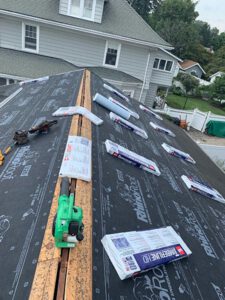There are a few things to keep in mind when deciding to get a new roof. Whether it is for aesthetic or structural reasons, a new roof can be a great way to bring your home up to date. A re-roof can add depth to your home and give it a more three-dimensional look. In addition, it is less expensive than a roof replacement. Contact Roofers for some tips to help you decide which option is best for you.
If you’re planning to install new roofing on your home, you should pay special attention to the roof’s valleys. These areas tend to channel water and need extra protection. When installing self-stick underlayment, you can save yourself some time by doing it with two people. Simply fold the sticky side outwards and push it into the valley crease. Ensure that the edges of the paper overlap. When you’re finished, you should run the last row of paper over the top of the peak. A metal drip edge, a narrow strip of metal, facilitates water runoff. It protects the underlying wall. Dormers, which are raised sections of the roof that contain vertical windows, are also covered with a metal drip edge. An ice and water barrier prevents wind-driven rain and ice damage to the roof. The eaves, or lower edge of the roof, are the first three feet of the roof. Stone lintels have been used for roofs since prehistoric times. However, they aren’t suited for long-distance spans and are prone to uplift. Ancient Rome popularized stone arch structures, which were ribbed and could span spaces up to 45 meters across. For about 2,000 years, stone arch structures dominated major architectural works. After the Industrial Revolution, iron beams replaced them. Throughout the 19th century, many churches and buildings in began to use glass and metal roofs. Asphalt is a common material used for roofing and is a bituminous organic compound. It is used in both composition shingles and roofing membranes. Asphalt is made using ASTM-D4586 (Asbestos-Free) standards. Asbestos-free asphalt roof cement is used for flashing and roof cement. The materials should meet ASTM-D4586 specifications, which are widely adopted. Roofing is a big decision, so make sure you do your research before you start a project. If you’re not sure about a new roof, you can always get a rolling roof. This is a relatively cheaper way to re-roof your home. You’ll still need to prepare the roof well for it to be installed. However, you can even get it installed in one day if you are willing to spend a few dollars. If you haven’t gotten the job done, consider hiring someone to do it for you. The materials you choose will depend on your building’s style. Flat roofs require big sheets of roofing material or clothes impregnated with asphalt. As a rule of thumb, the fewer joints, the fewer leaks there will be. Asphalt roll-roofing is the most basic type of roofing. It comes in three-foot rolls with protective granules on the top. The membrane is held in place with mechanical fasteners, glue, or rock garden ballast. Asphalt-based materials can be applied in many ways, and are the most common low-slope type. Most of these materials require professional installation. Asphalt-saturated felt, or tar paper is a material that is impregnated with asphalt. However, this roofing material is not waterproof and must be installed by a professional. For example, asphalt-saturated felt is not suited for flat surfaces. Instead, you can use liquid-applied fiberglass or acrylic materials.
Another common DIY roofing project question is: how many nails should I use for roofing? If I have a nail gun, should I use a staple gun or hammer to secure the shingles? For a good result, you should use nails rather than staples. Compared to staples, nails offer a higher holding power. Using nails, you should use more nails per shingle. The longer the nail, the stronger the shingle.

